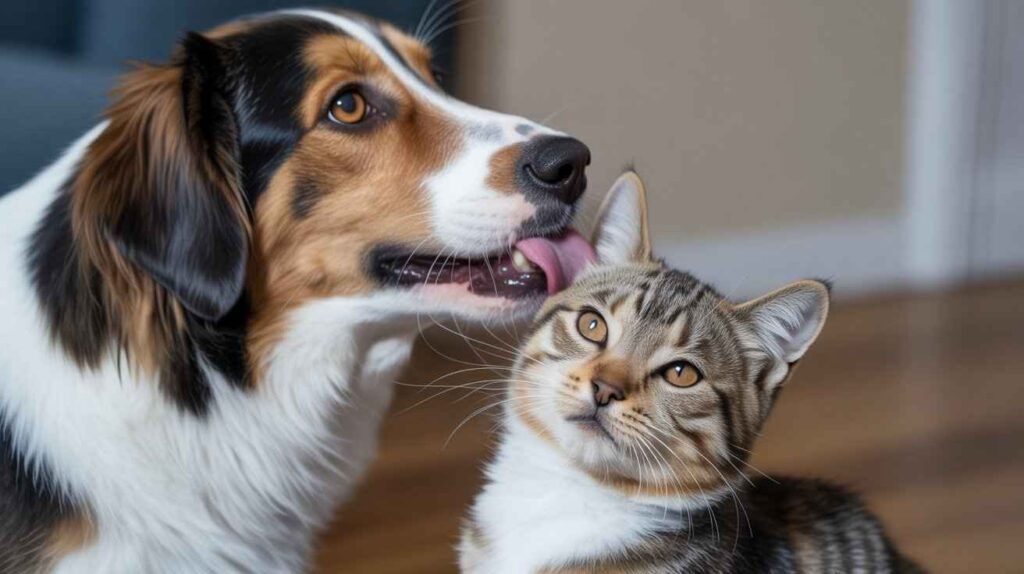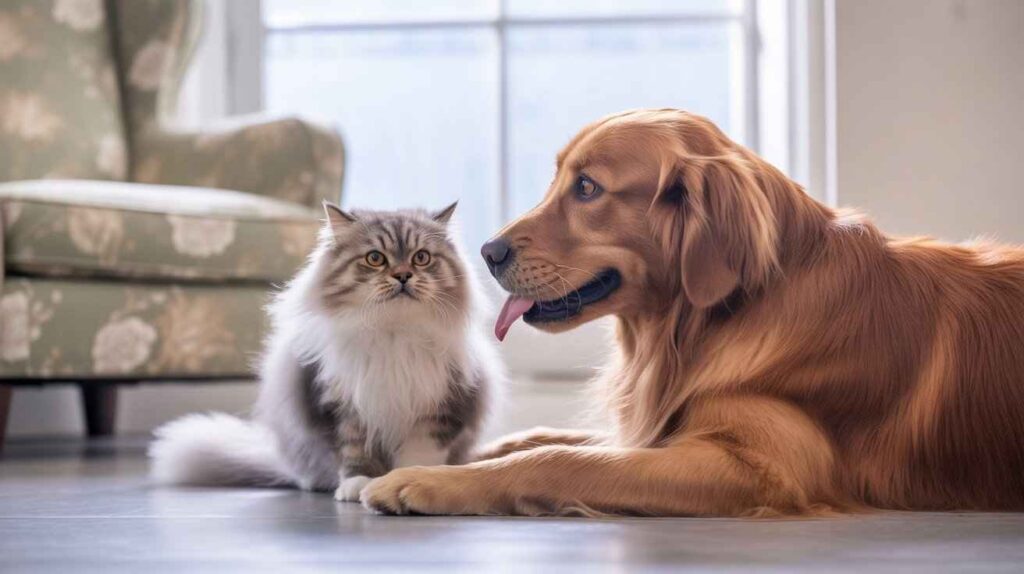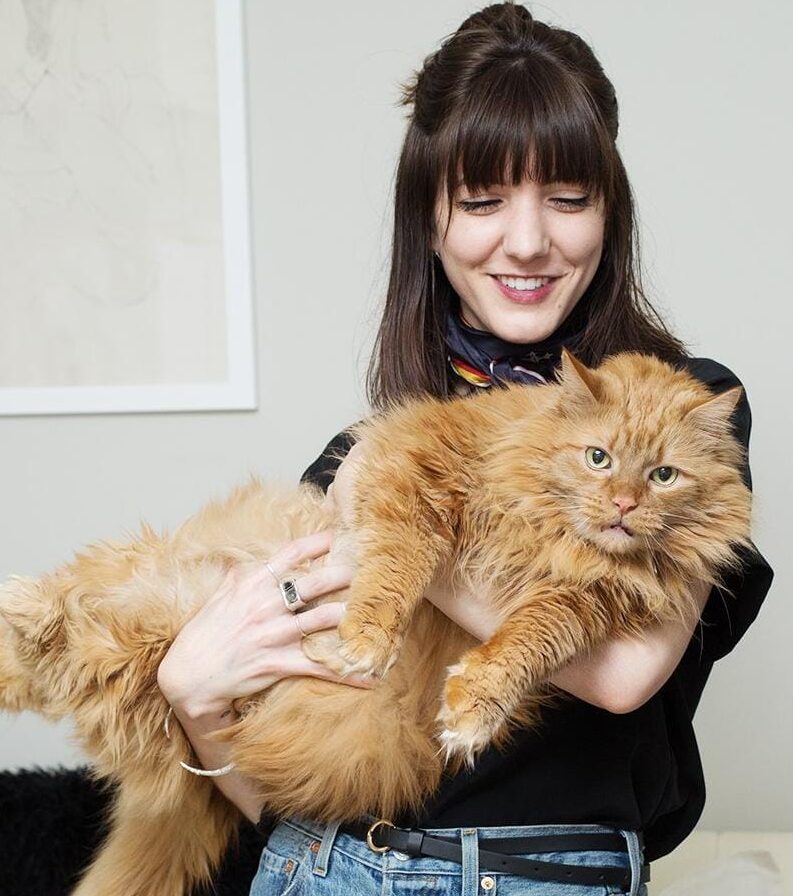8 surprising reasons why your dog grooms your cat: 1. Bonding 2. Pack behaviour 3. Affection 4. Stress relief 5. Scent marking 6. Care 7. Habit 8. Instincts
Why Your Dog Grooms Your Cat
If you’ve ever wondered, “Why does my dog groom my cat?” you are not alone. Many homes with both pets notice this unusual but sweet behaviour—dogs licking a cat’s fur, ears, or even paws.
At first glance, it appears adorable and loving, almost as if they are best friends. But grooming can mean different things.
Sometimes it shows affection and bonding, while other times it may signal stress, dominance, or even medical issues.
Knowing the difference helps you understand when it’s okay to enjoy the cuteness and when you should take action to protect your pets.
8 Common Reasons Why Dogs Groom Cats
Dogs and cats don’t always “speak the same language,” but grooming is one way they connect. Here are the main reasons dogs lick or groom cats:
Quick Table of Reasons
| Reason | What It Means |
|---|---|
| Affection | Dog shows love and bonding |
| Cleaning Instinct | A cat’s smell or taste attracts the dog |
| Curiosity | Dog copies cat’s grooming style |
| Stress Relief | Licking calms the dog |
| Copying Behavior | A dog uses licking to show control |
| Dominance | A cat’s smell or taste attracts the dog |
| Medical | The cat has a sore or an infection, and the dog notices |
| Habit/Obsession | Grooming turns into a strong habit |
![A friendly Golden Retriever dog lies next to a relaxed brown tabby cat, appearing to lick or nuzzle the cat. The cat is resting on a fluffy cream pillow in warm sunlight. [Why Your Dog Grooms Your Cat?]](https://catscare.blog/wp-content/uploads/2025/09/why-your-dog-grooms-your-cat-1-1024x574.jpg)
8 Common Reasons Why Dogs Groom Cats
- Affection & Bonding – Dog shows love, trust, and friendship.
- Cleaning Instinct – Helps remove dirt, crumbs, or loose fur.
- Curiosity & Smells – Cats’ natural scent and oils attract dogs.
- Stress Relief – Licking can calm a dog when it is anxious or bored.
- Copying Behaviour –The Dog imitates the cat’s grooming habits.
- Dominance – Sometimes used to show control over the cat.
- Medical Reasons – The dog senses a wound, sore, or infection on the cat.
- Habit or Obsession – Repeated licking becomes a routine or problem.
Regular Grooming vs Problem Grooming
It is essential to know when grooming is harmless and when it may be a problem.
| Type | Signs | Meaning |
|---|---|---|
| Normal Grooming | Calm licking, short sessions, relaxed body, cat sits happily | Shows love and bonding |
| Problem Grooming | Constant licking, the dog pins the cat down, the cat runs or hisses | Shows stress, dominance, or obsession |
Health & Hygiene Risks
While a dog grooming a cat often looks cute, there are some risks you should know. Dog saliva contains bacteria that may cause minor skin issues in cats.
If a dog licks the same spot too much, the fur becomes wet, matted, or sore. This can lead to skin irritation. If your cat has a cut or wound, licking may slow healing and can even spread germs.
In rare cases, bacteria from dogs can be transmitted to cats. To stay safe, always check your cat’s fur and skin, clean the licked areas if necessary, and watch for signs of redness or hair loss.

When to Call the Vet or Trainer
Most of the time, this behaviour is harmless. However, sometimes professional help is necessary.
- Call the vet if your cat develops redness, sores, or bald patches where the dog has been licking.
- Call a trainer if your dog seems obsessed, ignores commands, or shows dominance by pinning down the cat.
- Early intervention helps keep both pets safe, reduces stress, and ensures they can live together happily.
How to Stop a Dog from Grooming a Cat
If grooming becomes too much, here are simple ways to manage it:
- Redirect Attention – Offer toys, chews, or treats as an alternative to the cat.
- Teach Commands – Words like “leave it” or “gentle” can be beneficial. Reward your dog when it listens.
- Separate Spaces – Provide your cat with safe resting areas that the dog cannot access.
- Keep Pets Busy – Dogs often lick when bored. Walking, playing, and engaging in puzzles can help reduce stress.
- Protect Injuries – If the cat has a wound, cover it and keep the dog away.
- Seek Professional Help – If licking becomes an obsession or causes conflict, consult a veterinarian or a qualified animal trainer.
Tip: Stopping grooming doesn’t mean stopping love. With patience, your dog can learn healthier ways to bond with the cat without upsetting it.

FAQs
Q1. Is it normal if my dog grooms my cat?
Yes, often it is normal and affectionate. Dogs see cats as part of their family.
Q2. Can dog saliva harm my cat?
Sometimes. Dog saliva has germs that may cause skin redness or irritation if licking is constant.
Q3. Why does my dog lick my cat’s ears or private area?
These places have strong smells. Dogs are curious, but if your cat feels upset, stop the behavior.
Q4. How can I stop my dog from licking my cat too much?
Teach simple words like “leave it” or “no”, and give a toy instead. This keeps your dog busy and happy.
Q5. Is grooming a sign of dominance?
Yes, sometimes. If your dog also pins the cat down or acts bossy, it may be showing dominance.

Hi, I’m Sana Sajid!I’m the voice behind CatsCare.blog, sharing my 10+ years of hands-on cat care experience. With a diploma in animal care, I offer practical tips, trusted advice, and easy-to-follow guides to help keep your cats healthy and happy.
When I’m not writing, I spend time with my own cats or exploring the latest developments in feline health. Follow CatsCare.blog for expert insights and real cat stories!

![A white and brown dog gently licks the ear of a sitting brown tabby cat in a close-up indoor shot. [Why Your Dog Grooms Your Cat?]](https://catscare.blog/wp-content/uploads/2025/09/Why-Your-Dog-Grooms-Your-Cat.jpg)
![A medium-sized dog with a black, brown, and white coat is leaning over a tabby cat that is lying on its back on a beige carpet. The dog has its mouth slightly open and is looking directly at the camera. The cat is looking slightly to the side with wide eyes. They are both on a carpeted floor indoors, with a blurry background showing furniture. [Why Does My Dog Hump My Cat?]](https://catscare.blog/wp-content/uploads/2025/09/Why-Does-My-Dog-Hump-My-Cat.jpg)
![A realistic photo of a dog arching its back like a cat while stretching outdoors on green grass, captured in natural daylight. [Why Your Dog Arches His Back Like a Cat?]](https://catscare.blog/wp-content/uploads/2025/10/Why-Your-Dog-Arches-His-Back-Like-a-Cat.jpg)
![A golden retriever is stretching on a fluffy beige rug in a pose similar to a cat's "downward dog" stretch. Its front legs are on the ground and its rear is up in the air with its tail raised, as it looks forward.[Why Does My Dog Stretch Like a Cat?]](https://catscare.blog/wp-content/uploads/2025/09/Why-Does-My-Dog-Stretch-Like-a-Cat-1.jpg)
